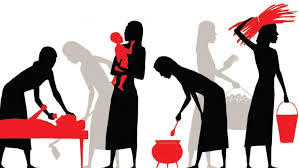For many years, Patricia’s daily routine entailed a gruelling schedule spanning from arranging breakfast upon dawn to getting her children ready for school. In between these duties, she dabbled in other such chores as tending to her mini garden, feeding her birds and tidying the house.
By the time she arrived at the school where she taught English, her body would have succumbed to the stress of her morning’s labour. “My doctor has repeatedly stressed the importance of taking a rest during consultations,” Patricia, who is now nearing her fifties, shared. Chronic muscular pains in her waist and back often caused her to break down while working. “There’s always one thing or another that needs to be done,” she lamented.
Patricia’s story is not unique; globally, women carry out a disproportionate share of unpaid domestic and care work, which involves physically taxing activities such as cooking, cleaning, laundry and caregiving. According to a report by UN Women, women perform approximately three times more unpaid domestic labour than men. In some regions, the statistics are even higher. In South Asia and North Africa, for example, women spend as much as 80% of their time on unpaid care activities.
These repetitive and strenuous tasks take a significant toll on women’s physical health and affect every facet of their lives. These daily physical strains diminish their quality of life and hinder their ability to engage in other productive activities.These disparities highlight how deeply entrenched gender roles shape the division of labour within households, yet its toll on women’s well-being remains inadequately acknowledged.
A study published in PLOS ONE highlights the prevalence of musculoskeletal pain (MSP) among women who engaged in heavy domestic chores such as scrubbing floors, lifting children and fetching water or firewood. According to the study, women in rural and low-resource settings are particularly affected owing to limited access to labour-saving devices and infrastructure. For instance, many women in such areas manually cart water containers over long distances or work in poorly ventilated kitchens, which leaves them prone to respiratory hazards and exacerbating joint damage.
The health risks of domestic work extend beyond physical strain to include mental-health challenges and occupational injuries. A report from the National Library of Medicine highlights the prevalence of injuries such as burns, cuts and respiratory issues leading from exposure to industrial chemicals and poor ventilation. Hypertension, arthritis and cardiovascular diseases are also said to be prevalent among women undertaking prolonged unpaid labour.
There is also the increased rates of anxiety and depression among women from repetitive and undervalued labour. Research has established a strong link between extensive unpaid labour and mental health challenges, including depression and anxiety. One study published in the journal Social Science & Medicine indicates that women who spend significant time on unpaid domestic work report higher levels of psychological distress than their male counterparts.
Additionally, a report from ScienceDirect highlights the broader societal consequences of unpaid domestic labour. The constant stress and lack of adequate rest perpetuate a cycle of neglect for women’s physical and emotional health, affecting their overall life expectancy. Stress-related ailments, coupled with societal expectations to perform these tasks without complaint, further underline the invisible and unacknowledged sacrifices of women.
For all the sweat and toil, unpaid domestic work is often excluded from economic metrics. The International Labour Organisation (ILO) estimates that the global economic value of unpaid domestic labour amounts to $10.8 trillion annually. Women’s unpaid labour subsidises the economy but limits their participation in the formal workforce. This creates a vicious cycle: women’s economic dependency reinforces traditional gender roles, which, in turn, exacerbates the burden of unpaid domestic work.
If the impact of domestic work on women’s well-being is not uniform, it is mediated by factors such as race, class and geography. In high-income countries, middle- and upper-class women often outsource domestic chores to paid domestic workers, who are predominantly women of colour or immigrants.
Yet cultural norms play a significant role in perpetuating the unequal distribution of domestic work, as Patricia highlights. In many societies, domestic chores are viewed as women’s “duty,” reinforced by traditional gender roles and expectations. In conservative communities, women who delegate domestic tasks may face social stigma or accusations of being “unfit” mothers or wives. Such cultural pressures compound the mental and emotional toll of domestic work, trapping women in a cycle of unrecognised labour and self-sacrifice.
Addressing the impact of domestic work on women’s well-being requires acknowledging the value of domestic work. This means investing in infrastructure and technology, such as access to clean water, electricity and labour-saving devices, to significantly reduce the time and effort required for domestic chores.
“Encouraging a more equitable division of domestic responsibilities between men and women is also important. Not because I am trying to be the head of the home but to reduce the burden, especially when the children are too little to help me,” Patricia says, emphasising the need for public awareness campaigns, workplace policies and educational initiatives to challenge traditional gender norms and promote shared caregiving roles.
Across the world, several countries have moved to alleviate the burden of domestic work. Nordic countries, for example, have introduced paid parental leave and subsidised childcare services, helping to redistribute domestic responsibilities more equitably. In Argentina, the government’s “Cuidar en Igualdad” campaign focuses on promoting gender equality in unpaid care work through legislative reforms and public awareness programs.
India’s Mahatma Gandhi National Rural Employment Guarantee Act (MGNREGA) includes community-based childcare centres that enable women to balance paid work with caregiving duties. These examples demonstrate the transformative potential of policy interventions in reducing the burden of domestic labour on women and achieving a just society.
Patricia's story of balancing household chores with her teaching job illustrates the global issue of women disproportionately handling unpaid domestic work. Women's roles in household tasks such as cooking, cleaning, and caregiving contribute to significant physical and mental health challenges, including musculoskeletal pain, injuries, anxiety, and depression. The unequal distribution of chores is exacerbated by societal norms and traditional gender roles, often trapping women in cycles of unrecognized labor and reducing their opportunities in the formal workforce. Reports highlight that globally, women perform unpaid labor that amounts to $10.8 trillion annually, subsidizing the economy yet reinforcing economic dependency and traditional roles.
Addressing this issue requires acknowledging the value of domestic work and promoting equitable division of responsibilities. Solutions include investing in infrastructure, adopting workplace policies, and launching public awareness campaigns to challenge norms. Some countries, like Nordic nations and Argentina, have implemented policies like paid parental leave, subsidized childcare, and legislative reforms to support gender equality in domestic work. India's MGNREGA offers childcare to aid women in balancing work and caregiving duties. These initiatives demonstrate the power of policy in alleviating women's domestic labor burden and fostering a just society.






